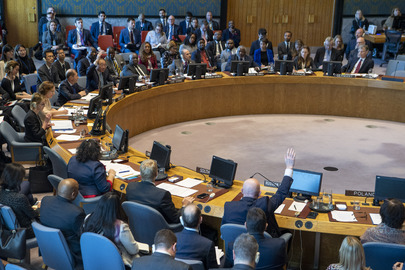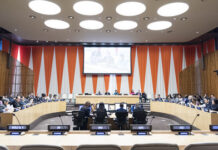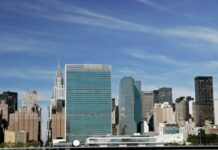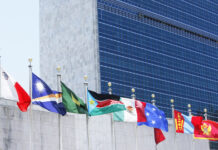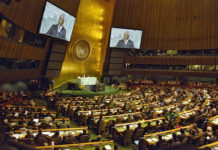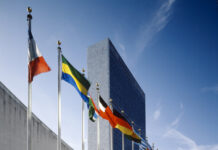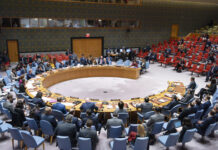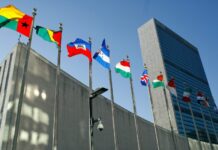Vibhu Mishra/UN News: Can you tell us about the Dzud, what should we understand when we hear this term?
Tiziana Bonapace: The Dzud phenomenon is a slow onset disaster, which is unique to Mongolia. In fact, Dzud means disaster in Mongolia, and it results from a combination of summer drought followed by heavy snow falls and extreme cold. This leads to insufficient grazing pastures both in summer and winter, which results in under-fed animals that are unable to build up fat reserves needed for winter survival. Livestock mortality increases significantly during Dzuds and for a culture where livestock is integral, in particular for the nomadic style of life, the Dzuds can be devastating.
UN News: Given that Mongolia faces Dzuds almost every year, why is it so extreme this season?
Ms. Bonapace: It is extreme this time because it combines two phenomena. One is what we call the “white Dzud”. This is deep snow cover along the plains, which prevents animals from accessing grass, and we need to remember that these are animals that are already under-fed and lacking the fat reserves because of the summer droughts. This white Dzud prevents them from accessing the passages. Then there is often a short thaw, a slight increase in temperature and melting of the snow but it is quickly followed by a hard freeze. And this freeze turns the melted snow turn very quickly into ice, locking up the pastures in ice and this is what is known as an “iron Dzud. This year, it a combination of both the show cover and then the pastures locked up in ice, and the combination of these two phenomena this year, have made the Dzud particularly strong and extreme.
UN News: A recent ESCAP noted that climate change also plays a major role in the Dzud getting worse. Can you explain how the changing climate is influencing Dzuds?
Ms. Bonapace: In our latest Asia-Pacific Disaster Report, which is published every two years, we have highlighted the emerging scenarios for a world that is hurtling to the 1.5°C to 2°C warming. For Mongolia, not surprisingly, we find that the frequency and intensity of Dzuds is going to increase and unfortunately, the stresses that increased intensity and frequency of Dzuds brings – it triggers a vicious circle – it triggers deforestation, it triggers overgrazing, and it triggers land degradation, and all of these really amplify the impacts of Dzud and lead to long-term irreversible consequences.
UN News: ESCAP is one of the few UN entities to have a dedicates space programme for sustainable development. How is it using space technology and other new technologies to mitigate disaster risk?
Ms. Bonapace: [Use of technology,] I think, is one of the things that hold out hope for everyone. Things look bad but technology innovation, and in particular space application innovation and is really opening a huge array oof tools that help us deepen our understanding of this phenomena and they help us predict with far greater accuracy, what is going to happen. ESCAP has a regional space applications programme, which started in 1994. It is really a programme that – I think – had a lot of foresight. Who would have known in 1994 that a programme like this would become so useful. This programme taps into the expertise of the space-faring countries and all the satellite images that they generate, combining this this information, the satellite derived information and expertise with the needs of countries that are not spacefaring. On our part, ESCAP facilities this exchange
UN News: With the unique role of ESCAP, how are you are bringing countries together to address other similar disasters and crises that span international borders.
Ms. Bonapace: We are working on a virtual constellation of satellites that will provide very high-resolution satellite imagery to countries that are at high risk of disasters and relatively low disaster analytical capacities. There is a charter [, an international agreement on space and major disasters] that is triggered when a disaster hits and then the countries that have satellites over that disaster-affected area provide the satellite imagery for free. This happens post disaster, when the damage the destruction everything has happened, and it plays a key role in the disaster response. ESCAP is working on a system, very similar to the one that exists post-disaster, but a system that will exist pre-disaster and will provide such images to the countries, requesting such images for particular disaster risk hotspots, and having this information and being able to analyze how the risk hotspots are evolving, and what the likely people and environmental impacts of a disaster will be enables governments to prepare in advance and put into place policies that can be triggered very quickly if and when, a disaster hits. And being prepared pre-disaster ensures that the disaster is managed more actively through its entire cycle.
UN News: That was a very nice way to round up on how you are also, addressing the vulnerabilities before the disasters strikes. Before we conclude, would you like to add anything from your end?
Ms. Bonapace: Only, just to re-emphasize the points that early warning is the key. There is a global executive action plan on early warning for all that was launched at COP27. ESCAP has been given a mandate to implement a regional strategy on early morning, as more and more disasters are climate-related and are also transboundary. Therefore, regional collaboration among countries becomes even more important, and ESCAP has been asked to implement a such as a regional strategy. It is a key priority for us, and we are working in close collaboration with our member States, and we are also working very closely with our partners to ensure that we leverage on the increasing opportunities that innovations in digital technology and space applications are bringing every day. The picture is a little dismal at the moment, but there is hope for a more resilient future.
Source of original article: United Nations (news.un.org). Photo credit: UN. The content of this article does not necessarily reflect the views or opinion of Global Diaspora News (www.globaldiasporanews.com).
To submit your press release: (https://www.globaldiasporanews.com/pr).
To advertise on Global Diaspora News: (www.globaldiasporanews.com/ads).
Sign up to Global Diaspora News newsletter (https://www.globaldiasporanews.com/newsletter/) to start receiving updates and opportunities directly in your email inbox for free.


